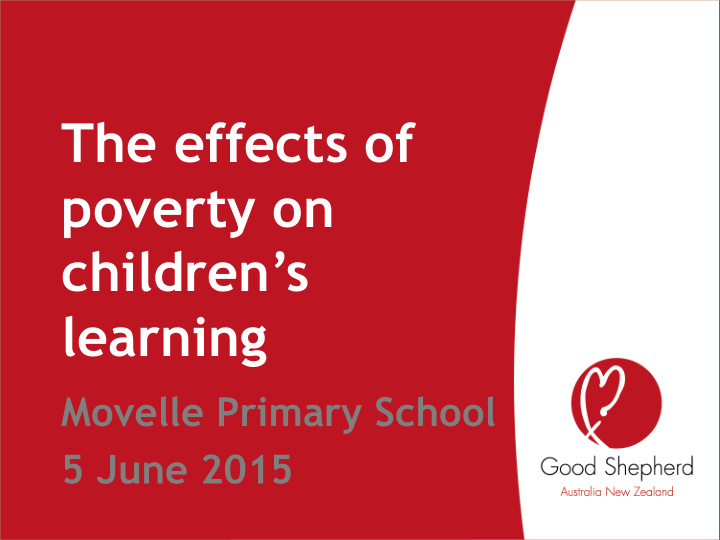



The effects of poverty on children’s learning Movelle Primary School 5 June 2015
Goals for the morning By the end of the session, we will have: o Increased understanding of and empathy for children experiencing poverty o Identified best practices at Movelle Primary School o Created a list of strategies to improve support o Discussed self-care and mutual care o Left with a list of accessible, helpful resources
Case studies Barriers to completing homework No shoes for school 1.Very brief summary of case study. 2.What are the primary issues? 3.How could the teacher successfully respond? 4.How could the school successfully respond? 5.Other insights?
What is poverty? Limits choice, limits access Health Resources Language & culture Social connections
Effects of poverty on children Children living in poverty are at higher risk of experiencing… o Reduced social and emotional competence o More behaviour problems o Academic underperformance o Lower wage earnings and reduced home ownership rates o Reduced overall health and increased risk of morbidity
Reality check: Australia • Almost 24% of Australian children developmentally vulnerable; almost 12% experiencing multiple vulnerabilities (preschool, 1 AEDI) Australian children from low-Socio-economic backgrounds are: • 11 - 16% behind peers in reading (NAPLAN) • 2.5 years behind academically at age 15 (PISA) • 20% 15-year-olds report low sense of belonging (PISA) • 20% 15 year-olds identified as having low participation (PISA) • 20% less likely to finish year 12 (COAG) • Largest decline in employment, education or training post- school(COAG) – 59.4% in 2011 (COAG)
St Albans & child vulnerability *Australian Early Development Census AEDC* Table: Percetage of children developmentally vulnerable in 2012 40 35 30 25 20 15 10 5 0 Physical Social Emotional Language Communication Vul 1 Vul 2 Australia Victoria Brimbank St Albans
What can be done? Well- being: “Optimal psychological functioning and experience.” (Ryan & Deci, 2001, p. 142) Not merely the absence of pathology, but also the presence of positive, healthy psychological function allowing an individual to flourish and thrive. Positive emotions Social connection Planning & goal-setting
Well-being & positive emotions (1) Hedonic well-being Eudaimonic well-being • Avoiding pain and seeking • Sense of meaning and pleasure purpose • Internal focus • External focus Higher Increased Increased Improved Increased Increased career life social resilience health persistence status satisfaction connection (Almeida, (Pressman & (Wrosch et al, (Boehm & (Keyes, et al (Helliwell & 2005) Cohen 2005) 2003) Lyubomirsky, 2002) Putnam, 2004) 2008)
Well-being & positive emotions (2) Positive emotions Negative emotions Persistent positive Chronic negative emotions… • emotions… Reduces holistic thinking • • increases expansive Reduces creative problem-solving • thinking Reduces ability to make realistic • Promotes healthy reward long-term plans • system Reduces resilience • • Increases resilience Compromises healthy reward system • increases thriving in all domains Happy people are more successful, not the other way around
Social connection & well-being Positive social relationships (both quantity and quality)… o Increase resilience o Increase well-being and positive emotion states o Improve cognitive processing → Children from disadvantaged or socially excluded households may need to actively learn social skills and the signs of a positive, healthy relationship.
Planning, goal setting & well-being Individuals experiencing chronic stress or anxiety… o Tend to have an external locus of control – passive recipient o Tend to experience neutral events as negative o Are easily overwhelmed by long-term timeframes What helps: o Maintain an internal locus of control – self-determination o Reframe issues to reduce anxiety o ‘Chunk’ plans into manageable sub -components o Have a contingency plan
Where can we effect change? Things in Things your Universal you can control response: influence Skills, abilities, attitudes Things you that are applied to all can’t children influence Individual response: What does the school do well to support School systems, policies, students’ well -being – emotionally, socially, norms for responding to specific issues and planning/goal-setting skills?
What specific actions can we take to improve the well-being of our students? What specific actions can we take to… o decrease students’ experience of stress/anxiety & increase their experience of positive emotions? o increase students’ ability to make and sustain positive social connections? o increase students’ planning and goal -setting skills? → Other actions outside of this scope – write down & we will add it to plan.
Let’s not forget self -care Things in Things your Universal you can control response: influence Skills, abilities, attitudes Things you that are helpful to all can’t teachers influence Individual response: School systems, policies, What can we do to ensure our teachers norms for supporting teachers’ well -being & and staff maintain their well-being? best practice
Recommend
More recommend